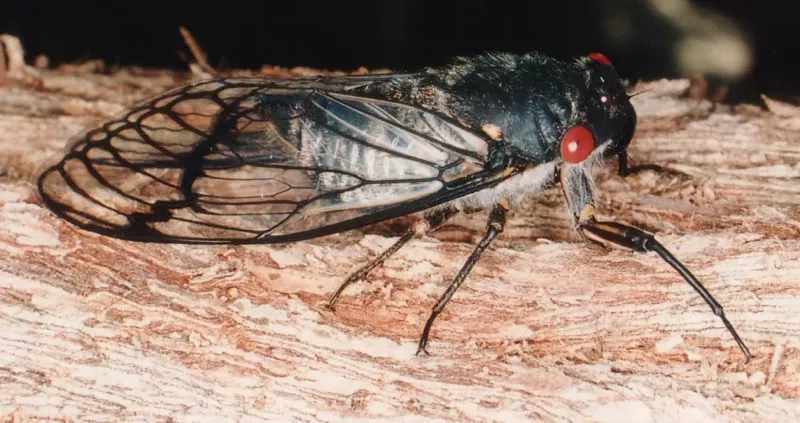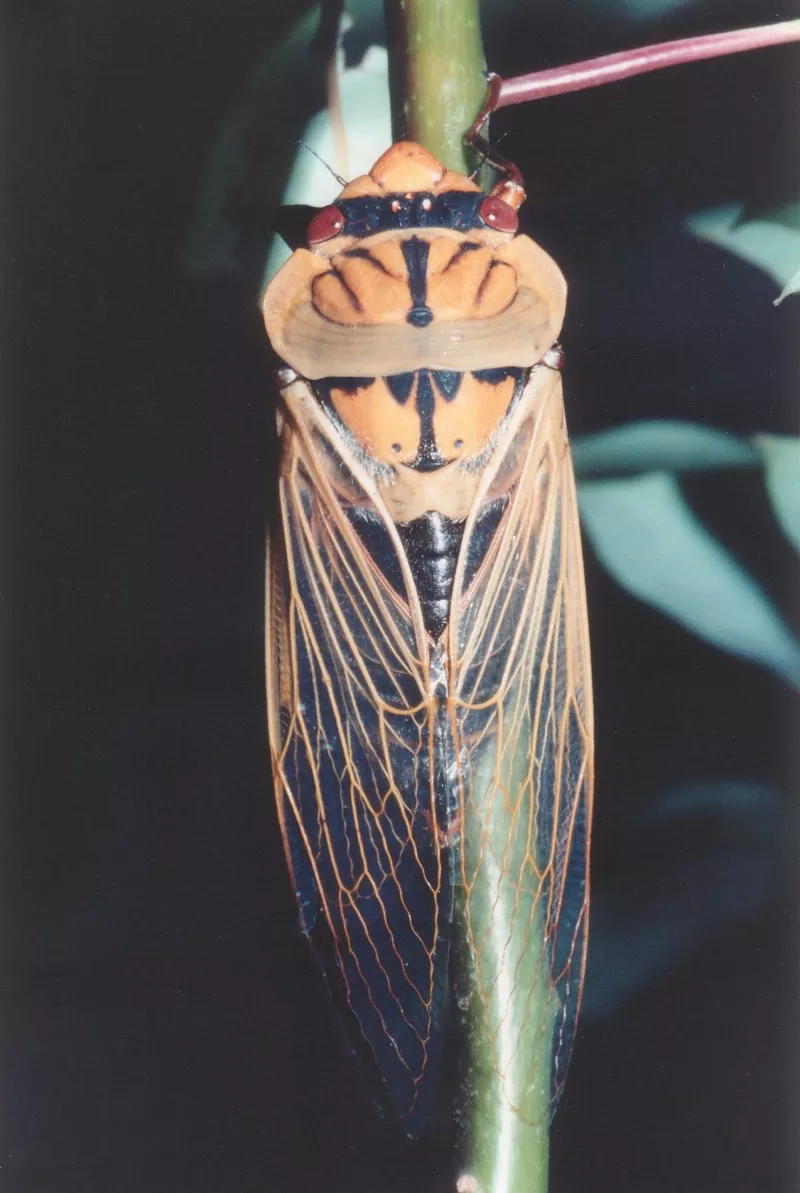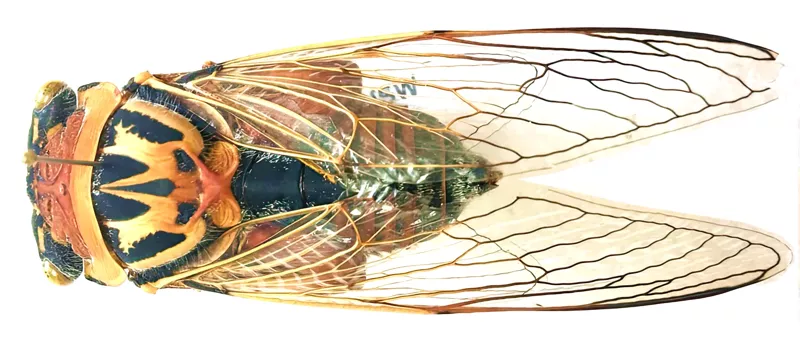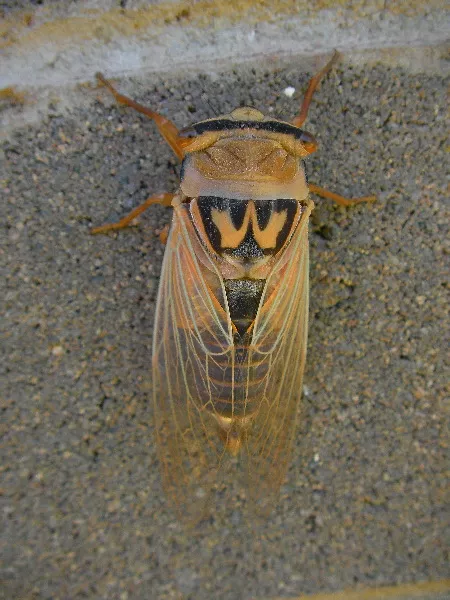This page features information about common cicadas of Australia researchers, and websites dedicated to the cicadas of Australia. Australia has the best cicada names!
Bladder Cicada (Cystosoma saundersii)
The Bladder Cicada can be sound in eastern Queensland & NSW1, can be found September-January, peaking in October2. It is called a Bladder Cicada because of its large abdomen.
- Cystosoma saundersii (bladder cicada)
- Bladder cicada trading card
- Mating Bladder cicadas
- Bladder Cicadas out in Sydney
Cyclochila australasiae
Cyclochila australasiae can be found in eastern Queensland, NSW and Victoria, and most emerge between September & December1, but peaking in November2.
Green Grocer morph of Cyclochila australasiae
Green Grocer morph of Cyclochila australasiae

Photo by Kevin Lee. Yellow-Green Green Grocer with Mask.
- Green Grocer (Cyclochila australasiae) photos by Kees Green
- Kevin Lee’s Green Grocer Photos
- Green Grocer (Cyclochila australasiae) photo by Bron
- Green Grocer
- Green Grocer Emerging
- Cyclochila australasiae (Donovan, 1805)
- Green Grocer Merch
Yellow Monday morph of Cyclochila australasiae

Photo by Tom Katzoulopolopoulous.
Blue Moon morph of Cyclochila australasiae
Masked Devil morph of Cyclochila australasiae
Bagpipe Cicada (Lembeja paradoxa)
The Bagpipe cicada can be found in the Northern tip of Queensland1, from October to February, but they’re most common during January2.
Cherrynose or Whiskey Drinker (Macrotristria angularis)
The Cherry Nose cicada can be found in Eastern Queensland, NSW, and a small part of South Australia, and is found November-February1, but is most common in December2.
Double Drummer (Thopha saccata)
The Double Drummer can be found in parts of eastern Queensland and Eastern NSW, from November to early March1. Peaks in December.
White Drummer (Arunta perulata)
The White Drummer cicada can be found in eastern Queensland and NSW, from November to April, but they are most common during December and January1.
Orange Drummer (Thopha colorata)
When: January.
- Orange Drummer (Thopha colorata) photos by Jodi
- Orange Drummer cicadas
- More cicadas from Australia: Orange Drummers
Redeye cicada (Psaltoda moerens)
The Redeye cicada can be found in eastern NSW, Victoria, and Tasmania, and are most abundant in late November and December1, but can be found until February2.

Photo by David Emery.
- Timelapse video of a Redeye Cicada Molting
- Ozzie Cicadas: Redeye cicada
- Psaltoda moerens (Germar, 1834)
Golden Emperor (Anapsaltoda pulchra)
When is it out: Nov-Jan.
Floury Baker (Aleeta curvicosta)
The Floury Baker can be found along the coast of Queensland & NSW. Adults are most common in late December and January1.
Tiger Prince or Tiger Cherrynose (Macrotristria godingi)
Golden Twanger aka Diemeniana euronotiana
The Diemeniana euronotiana can be found in eastern NSW, south-eastern Victoria, and Tasmania. They are most common from late November to January1.

Diemeniana euronotiana. Photo by David Emery.
Tasmanian Hairy Cicada aka Tettigarcta
Out: January-May.
More interesting names:
- Brown Bunyip (Tamasa tristigma)
- Typewriter (Pauropsalta extrema)
- Sandgrinder (Arenopsaltria fullo)
- Silver Knight (Psaltoda plaga). Psaltoda plaga photo by Kevin Lee. Psaltoda plaga (Walker, 1850) (Dr. Pop website)
Date and location:
1 Moulds, M.S.. Australian Cicadas Kennsignton: New South Wales Press, 1990.
2 iNaturalist.com.
Researchers & resources:
David Emery
David Emery is a cicada researcher and has contributed many of the images you see on this website.
Use this amazing image by David Emery to identify some of the most well-known Australian cicada species:
Nathan Emery
- Nathan Emery’s Great Cicada Blitz.
- Follow Nathan on Twitter @ecotechnica and on Facebook.
- Nathan Emery related posts on this site
Nathan Emery released a cicada book called “A photo guide to the common cicadas of the Greater Sydney Region”. You can buy it online.
Dr. Popple
- L. Popple’s website The Cicadas of Australia, is the best site for Australian cicadas.
- Follow @_DrPop_ on Twitter.
- Dr. Popple related articles on this site.














34 replies on “Australian Cicada Names”
Hi ,
Love your site.
Im 60 years old now but when I was 12 years old I was an avid cicada collector.
I had collected a few species in NSW Royal National Park which where new to
the Australian museum in the 1970s.
There is one thing that has always bugged me.
When I was a kid another kid showed me a cicada that was big and hairy and silvery white.
He told me it was called a White Whiskey.
Im a bit shocked to find that there is a cicada called a Whiskey Drinker.
So there is some connection with the word Whiskey.
The only other time I saw one was at school.
I spotted one way up a gum tree so I spent all afternoon throwing rocks at it.
I think the hairy white fur helped them to blend in with white gums.
Finally I got it and it fell dead to the ground and it was the same type of White Whiskey
that kid had shown me.
I have never seen one since.
Im just curious if you could shed any light on this for me?
Thanks
Mike
The Whiskey Nose is also known as a Cherrynose. or Macrotristria angularis. The cicada was called a Whiskeynose because people who drink a lot of hard liquor can develop rhinophyma that makes their nose look read. I suppose Cherrynose is a more polite way of saying that.
The closest Australian cicadas I know that is fuzzy and white is White Drummer (Arunta perulata) which has large fuzzy white “drums” or Floury Bakers, Aleeta curvicosta, which have a “dusty white pubescence” on them when they’ve recently molted… linking to a photo.
2018-2019 Cicada Sightings
I’ll post sightings I hear about on social media here:
2017-2018 reports of cicadas as I see them on social media
This might be handy for guessing when cicada species in Australia will emerge.
Recent Articles
I have photo of a bug, probably cicada, very big. It move from grunt to the tree to unfold its wings.
To whom I can send the photo for identification?
Alex
Email images to cicadamania@gmail.com
Great site, reminded me of the fun times as a young boy. me & my friends would climb the trees to catch cicadas around Sydney’s hills district area. Mostly green grocers & occasional yellow Monday. Another time my parents took us to Cowra & down by the river & in the trees were thousands of black princes which were rare in Sydney but common that summer in Cowra.
It’s sad that our kids these days don’t venture outdoors to experience the raw fun & adventures that we created for ourselves to enjoy.
My kids addicted to the virtual world, stuck in the web without spiders! Time flies in this fast changing world of ours.
My nephew is addicted to cellphones & Minecraft, but I take him around his neighborhood to look for cicadas whenever I can.
Hey, I’m in Melbourne and I found some cicada shells last night. I’ve been searching for them since I first heard their calls in November. I know there were three types of cicada calls in my nearby parklands, I eagerly listen out for them on my daily dogwalks.
The only thing is that these shells are the smallest shells I’ve ever seen!
Can cicada’s be identifed by their shells alone? I collected the ones I found. They are roughly 2-3cm long with a narrow abdomen (compared to greengrocers that I am most familliar with). Happy to send pics!
The call that was the most common in the area was a distinct ba-ba-ba-ba-ba-ba-brrrrrrrrrrr (repeated, with the ba- section going for anywhere b/w 15-26 beats).
Opal, yes they can. If you’re on Facebook, 90% of the top Australia cicada experts hang out here https://www.facebook.com/groups/cicadadiscussion
Otherwise, Dr Popple is the best resource on the web https://dr-pop.net/cicadas.htm. He doesn’t have photos of skins, but you might be able to contact him through the site.
Thank you so much, Dan! I feel I’ve finally found the secret society of Cicada lovers I dreamt of when I was six 🙂
I love the names that they give them!
What cicada has black top and black wings but orange underbelly
Maybe https://dr-pop.net/circumdata-398.htm Bronze Tree-buzzer
What a great site. Didn’t realise there were many other cicada trajics out there. Very much part of my childhood around Sydney in the 50s
About a year ago I tried to encourage Australia Post to do a series on cicadas..the sounds of summer. We’ll see.
We live on a farm at Lorne just outside Kendall NSw and the cicadas have been deafening this summer. Interestingly I have found no bladder cicadas this year and very few green grocers all the other varieties have been in abundance though. My granddaughters have had a marvellous time collecting and identifying them.
Hello. We have just returned from a couple of days camping on a property we have bought up near Gloucester/Barrington Tops in NSW. The noise from the cicadas was deafening. I’m wondering if you might be able to tell me which species they are likely to be in that area and if they they are likely to sing so loudly and in such large numbers in future years. Many thanks.
Wendy,
The loudest species is the Double Drummer/Thopha saccata — might be that.
See http://dr-pop.net/saccata-003.htm for a sound sample.
Others:
Razor Grinders http://dr-pop.net/eydouxii-018.htm
Redeyes http://dr-pop.net/moerens-089.htm
Green Grocers http://dr-pop.net/australasiae-048.htm
Plenty of Floury Bakers in the lower Blue Mountains right now. One flew in my car window as I was driving. It hit my shoulder and flew into the back seat. Upon recovering it, I noticed that its abdomen had popped off quite neatly. The poor bloke was still very much alive 6 hours later. Is this some kind of defense, like skinks dropping their tails?
We just moved to Artarmon area, very near to the station, and was surprised to hear the loud singing of Cicadas.
Though it might be music to some, I wanna know when do they stop. And are they dangerous ? My 3yo often go around them.
Thanks !
They aren’t dangerous in that they’re not venomous not do they transmit disease. Prolonged exposure to their song might cause hearing damage though. Double Drummers can get up around 120db. Definitely don’t put one up to your ear.
Just recorded some video of an absolute plague of Floury Baker, and what I thought were Black Princes, but after looking at some photos on this site I now think may be Red Eye,cicadas in my backyard at Elanora Heights, on Sydney’s northern beaches.
https://youtu.be/CZzHn5VpsOM
Very cool!
Missing is the Black Prince which was almost mythical and the dream of each kid to find one (I did it was very small). The female Green Grocers were called “Pissers because they sprad a clear liquid on you.
For us kids, who lived in Lane Cove, to catch them it was a sin to get them when they came out of their shells and were still wet. We believed if we gave a thousand wings to a certain company, they would give a wheel chair to a poor kid.
Since the Green Grocers had a four-year cycle and the Yellow Bakers a three-year cycle ever twelve years their emergence would coincide and the din was unbelievable. On off years just a few would come out.
“Blue moons” could occur wherever there are “green grocers” with an estimated frquency of 1/10000. But strangely enough, despite the absolute huge numbers of GGs about this 2013 season from September, no blue moons seem to have been found/ photographed/ handed to the Australian Museum. Claudine’s “indelicate” is probably the nickname given to female cicadas as males croak loudly when caught, females only can excrete water!
Chris, what species cam to dive into the pool?
WOW……what a site. Last night we had a late night swim in the pool and turned the lights on. Big mistake. There were cicadas coming from every here. Spent our time rescuing them all. We are in the Hawkesbury district. I am over the moon about the number of cicadas. We start them singing by shining a torch in the trees at night. Fabulous.
As a child I collected cicadas in Sydney. The boys taught me all the names & one of them is not mentioned probably because it is indelicate. It was called the Pisswacker presumably because it made no noise and released water on you , it was probably a female and did this when caught.
I am sitting in my mums backyard listening to their song and little else. I remembered the black price also but couldn’t remember the green grocer. Thanks for the memory kick is getting much more difficult as I approach my 60th.today is mums 86th.
where could you find the blue moon around Australia ??
Near Sydney (according to L. Popple). I’ve also read that they are more prevalent in hilly areas.
“My fav one is the blue moon how beautiful.”
How much is it possible?
Excellent page. Reminder of the glorious days of summer when I was a youngster.
You didn’t mention that the local pharmacist bought black princes wings and made some
special concoction from them.
Why were they known as “locusts” 50 years ago?
I think they called them locusts because they reminded people of the locusts that are actually grasshoppers.
haha – very cool in a nerdy way 🙂
That ‘chocolate soldier’ one is actually a ‘red rocket’ but i think the names for the other ones are very clever. My fav one is the blue moon how beautiful.